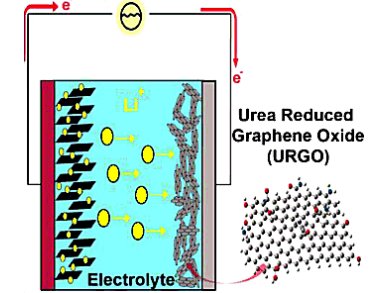Energy storage systems (ESSs) are of great interest to resolve urgent energy and environmental issues. Lithium ion capacitors (LICs) have drawn considerable attention. They utilize the advantage of high power of supercapacitors and of high energy of lithium ion batteries. However, the energy densities of conventional LICs, which consist of a pair of graphite and activated carbon electrodes, are limited by the small capacities of the activated carbon cathodes.
Jang Wook Choi, Korea Advanced Institute of Science and Technology, Daejon, Korea, and colleagues demonstrate high performance lithium ion capacitors (LICs) by employing cathodes based on urea-reduced graphene oxide (URGO). Prelithiated graphite is used as anode.
The amide functional groups generated during the urea reduction facilitate the enolization processes for reversible Li binding. This improves the specific capacity by 37 % compared to those of conventional systems such as activated carbon (AO) and hydrazine-reduced graphene oxide (HRGO) while preserving a similar power density.
This indicates that appropriately treated graphene can be a promising cathode for upcoming LICs.
- Functionalized Graphene for High Performance Lithium Ion Capacitors,
Ji Hoon Lee, Weon Ho Shin, Myung-Hyun Ryou, Jae Kyu Jin, Junhyung Kim, Jang Wook Choi,
ChemSusChem 2012.
DOI: 10.1002/cssc.201200549




